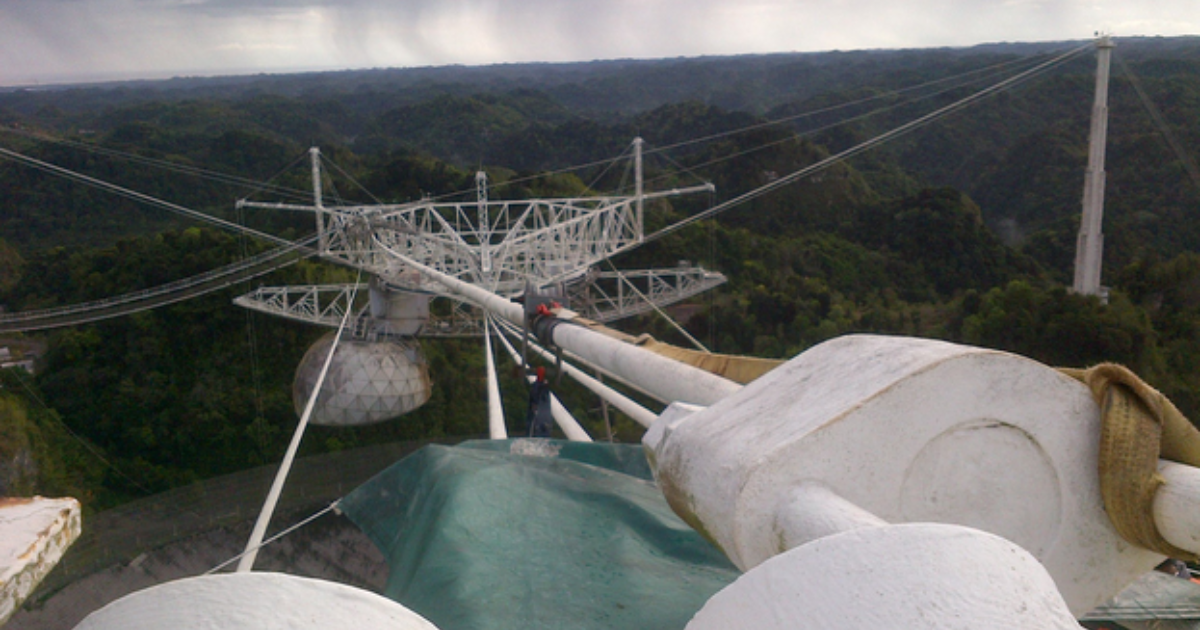

The only certainty is that Puerto Rico needs help right now - please consider donating to a relief fund if you can. While it sounds like repairs are feasible, can the NSF or any potential allies justify funding those repairs? It wouldn't be as simple as shutting down Arecibo (there are environmental considerations), so its fate is very much in limbo. Now, the telescope's future is even more in doubt. The NSF doesn't believe it can keep funding Arecibo itself, and has been looking for partners who could shoulder the burden. The hurricane compounds what was already a difficult period for the observatory. The National Science Foundation understands that team members have generators, a water well and food for a week, but the roads may be impassable for days. To make matters worse, the situation is dire for on-site staff. The gigantic central dish is intact, although the line feed's collapse punctured it in places. All staff members are thankfully safe for now, but an atmospheric radar line feed and a 39-foot dish (used for Very Long Baseline Interferometry) were lost in winds that reached up to 155MPH. Researchers have learned that the Arecibo Observatory and its signature radio telescope took significant damage when the hurricane passed over. And while the human tragedy is clearly the most important concern, it's also having a terrible effect on the scientific community. Many have been displaced from their homes, and the entire territory may go without electricity and reliable communication for months. Arecibo and other radars observing the asteroid detected it had two unexpected companions, or moons.Īrecibo is also famous for its use as a location in films, such as Contact and GoldenEye.Puerto Rico is suffering on an unimaginable scale in the wake of Hurricane Maria. One recent target of Arecibo was the triple asteroid Florence, which passed more than 4 million miles (7 million kilometres) from Earth on Sept. Initial reports from the Arecibo Observatory in Puerto Rico indicate powerful winds from Effects of Hurricane Maria in Puerto Rico - Wikipedia destroyed an antenna and damaged the radio telescope's huge 300-metre (1,000-foot) dish reflector, but the bulk of the facility remains intact and workers sheltered there were unharmed. The giant radio telescope has also sent signals into the Universe to probe for extraterrestrial life, and listened for signs of transmissions coming from other worlds.

6, sparing the observatory significant damage.Ĭonstructed in the early 1960s, the Arecibo Observatory is the world’s second-largest radio telescope, with its dish antenna nestled inside a natural karst depression.Īstronomers use Arecibo to investigate asteroids, planets, pulsars, galaxies and dark matter. Hurricane Irma passed just north of the island Sept. Hurricane Maria’s landfall in Puerto Rico marked the second time in two weeks Arecibo prepared for a tropical cyclone. The staff planned to secure the telescope, facilities and research equipment.

Officials at Arecibo Observatory announced Monday they began hurricane preparations. The access road leading to the observatory is still covered in debris and inaccessible, officials said.Ī weather station at Arecibo detected sustained winds of 78 mph (126 kilometres per hour) Wednesday morning, with gusts measured up to 108 mph (174 kilometres per hour), according to the National Hurricane Center.
Arecibo telescope damage by maria full#
“We will need a full assessment of the damage, repairs that are needed and when the observatory can resume observations,” said Nicholas White, senior vice president for science at Universities Space Research Association. Credit: USRAĪ 12-metre (39-foot) dish used as a phase reference for Very Long Baseline Interferometry was also lost, according to USRA. The 430 MHz radar line feed is seen extending to the lower right in this image. Arecibo uses different equipment for radio astronomy observations, but still relies on the same huge dish reflector. The 430 MHz line feed was used to transmit and receive radio waves for atmospheric research. But the dish suffered several punctures when a 29-metre (96-foot) line feed antenna fell from a catenary more than 100 metres above the reflector, officials said. The main dish of the famed telescope, which spans 305 metres (1,000 feet) across, was reported intact. While electricity and standard communications lines remain out, reports from the observatory were transmitted via shortwave radio, USRA said in a statement. USRA is part of a multi-institution team charged with operating Arecibo Observatory by the National Science Foundation. Staff and family members who rode out the storm at the observatory Wednesday are safe, but officials are still trying to contact other employees who sheltered in their homes and other safe places, according to the Universities Space Research Association, or USRA. Initial reports from the Arecibo Observatory in Puerto Rico indicate powerful winds from Hurricane Maria destroyed an antenna and damaged the radio telescope’s huge 300-metre (1,000-foot) dish reflector, but the bulk of the facility remains intact and workers sheltered there were unharmed.


 0 kommentar(er)
0 kommentar(er)
